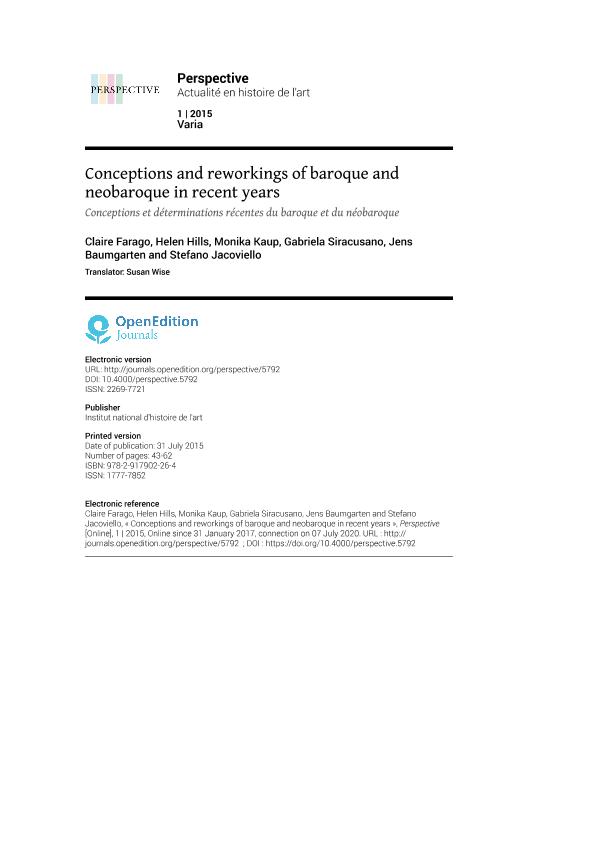Mostrar el registro sencillo del ítem
dc.contributor.author
Farago, Claire
dc.contributor.author
Hills, Helen
dc.contributor.author
Kaup, Monika
dc.contributor.author
Siracusano, Gabriela Silvana

dc.contributor.author
Baumgarten, Jens
dc.contributor.author
Jacoviello, Stefano
dc.date.available
2020-08-27T19:31:20Z
dc.date.issued
2015-07
dc.identifier.citation
Farago, Claire; Hills, Helen; Kaup, Monika; Siracusano, Gabriela Silvana; Baumgarten, Jens; et al.; Conceptions and reworkings of baroque and neobaroque in recent years; Institut national d'histoire de l'art; Perspective; 1; 7-2015; 43-62
dc.identifier.issn
2269-7721
dc.identifier.uri
http://hdl.handle.net/11336/112589
dc.description.abstract
Baroque needs to be thought across chronological and geographical divides to connect architecture and dance, painting and natural science, philosophy, sculpture and music (and not in the sense of representations of music) and, above all, in relation to encounters with difference – heavenly, earthly, social, political, religious, geographical. What possibilities in baroque are open now in relation to present dilemmas in art history and world events? Baroque enables – arguably, it demands – a radical rethinking of historical time – and a rethinking of familiar history. It permits a liberation from periodization and linear time, as well as from historicism. While the scholars below acknowledge that baroque is often equated with style or historical period, it is most productively thought beyond them. Mieke Bal has argued that baroque epistemology permits an “hallucinatory quality” of relation between past and present that also allows a release from a supposed academic objectivity, while insisting that the engagement with the past should remain discomfiting and profoundly disturbing.1 Instead of repressing the past and time, creative retrospection allows its implications to emerge. In its materiality and bodiliness, baroque undermines resolution, gropes towards fragmentation, overgrows, and exceeds. Baroque architecture may be seen as overflowing, an excess of ornamental exteriority and evasive proliferation. This brings to the fore the question of surface. Andrew Benjamin’s approach to surface as neither merely structural nor merely decoration in architecture is important here. Baroque time and form impinge on each other – that is, not simply the time that it takes to process point of view into form, but of form into point of view.2 Thus the pursuit is for a baroque vision of vision, a baroque audition of hearing, and a multitemporality. The question of materiality (not mere matter, materials, or technique) must also come into play.
dc.format
application/pdf
dc.language.iso
eng
dc.publisher
Institut national d'histoire de l'art
dc.rights
info:eu-repo/semantics/openAccess
dc.rights.uri
https://creativecommons.org/licenses/by-nc-sa/2.5/ar/
dc.subject
baroque
dc.subject
néo-baroque
dc.subject
wunderkammer
dc.subject
architecture religieuse
dc.subject.classification
Arte, Historia del Arte

dc.subject.classification
Arte

dc.subject.classification
HUMANIDADES

dc.title
Conceptions and reworkings of baroque and neobaroque in recent years
dc.title
Conceptions et déterminations récentes du baroque et du néobaroque
dc.type
info:eu-repo/semantics/article
dc.type
info:ar-repo/semantics/artículo
dc.type
info:eu-repo/semantics/publishedVersion
dc.date.updated
2020-08-25T15:23:41Z
dc.journal.number
1
dc.journal.pagination
43-62
dc.journal.pais
Francia

dc.journal.ciudad
Paris
dc.description.fil
Fil: Farago, Claire. State University of Colorado at Boulder; Estados Unidos
dc.description.fil
Fil: Hills, Helen. University of York; Reino Unido
dc.description.fil
Fil: Kaup, Monika. University of Washington; Estados Unidos
dc.description.fil
Fil: Siracusano, Gabriela Silvana. Universidad Nacional de Tres de Febrero. Instituto de Investigaciones en Arte y Cultura "Dr. Norberto Griffa"; Argentina. Consejo Nacional de Investigaciones Científicas y Técnicas; Argentina
dc.description.fil
Fil: Baumgarten, Jens. Universidade Federal de Sao Paulo.; Brasil
dc.description.fil
Fil: Jacoviello, Stefano. Università degli Studi di Siena; Italia
dc.journal.title
Perspective
dc.relation.alternativeid
info:eu-repo/semantics/altIdentifier/doi/http://dx.doi.org/10.4000/perspective.5792
dc.relation.alternativeid
info:eu-repo/semantics/altIdentifier/url/https://journals.openedition.org/perspective/5792
Archivos asociados
